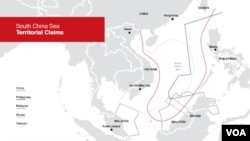China is widely forecast to bolster its military power next year in the South China Sea to resist Japan, India and the United States, as well as the Asian states that dispute Beijing's maritime claims.
Scholars believe China will eventually enhance radar surveillance and let fighter jets use tiny islets for stopovers. Beijing might declare an air defense identification zone or other means of maritime control, too, they suggest.
It probably hopes the United States, along with militarily powerful allies such as Japan and India, will stay out after they jumped into the dispute this year, according to Oh Ei Sun, international studies instructor at Singapore Nanyang University.
"I don't think they're primarily offensive in nature, but of course with those installations in place, they will have more bargaining chips, they're in a stronger position to say the U. S. should not perform [freedom of navigation operations] and such in the South China Sea," Oh said.
New hardware
China this year added installations in the Paracel and Spratly Islands, said the Asia Maritime Transparency Institute of the Center for Strategic and International Studies.
In 2017, China built underground storage areas, administrative structures and "large radar and sensor arrays," said the Washington-based research group. The construction covered about 290,000 square meters "of new real estate."
Beijing built most actively at Fiery Cross reef in the Spratlys, it said, including work to finish tunnels that are likely for ammunition storage. High-frequency radar gear also appeared on the reef, it adds.
China is the most militarized of six governments that claim all or part of the 3.5 million-square-kilometer sea, which is valued for fisheries and fossil fuels. It has been building up islets since 2010.
China has enough installations to land fighter jets, refuel, rearm and let crews rest, said Collin Koh, maritime security research fellow at Nanyang Technological University in Singapore.
State-run China Central Television said earlier in the month the military had deployed jet fighters to Woody Island in the Paracel chain.
China may draw a line of control around its holdings in the Spratly Islands, contested by four Southeast Asian countries plus Taiwan, and consider an air defense identification zone, the initiative's director Gregory Poling said.
China declared an air defense identification zone off its east coast, in a sea disputed by Japan, in 2013.
Outside influence
Analysts say China's buildup is aimed at claimants Brunei, Malaysia, the Philippines, Taiwan and Vietnam as well as powerful nations that do not claim ownership over the sea.
But the United States particularly irks China as a powerful arms supplier and military trainer for the Philippines. Washington sends naval vessels into the South China Sea periodically to back its position the waters are open to freedom of navigation.
"When the Chinese are suddenly trying to stop resupply of the Philippine forces at Pag-Asa or on the Sierra Madre [ship] at Second Thomas Shoal, then [Philippine President Rodrigo] Duterte is going to face an enormous amount of pressure to react strongly," Poling said, referring to two Manila-held features in the Spratly chain.
"The only way the Philippines can possibly react, really, is to strengthen the defense relation with the U. S.," he said.
India, a Western ally, upgraded its partnership with Vietnam last year year as part of its Act East policy, which analysts say is designed to check Chinese expansion.
Japan, an ally of the United States, passed a helicopter carrier through the sea in mid-2017, adding to repeated comments from Tokyo the waterway should be ruled by international law.
China bases its claim to about 90 percent of the sea on historical fishing records. It has eased the dispute through offers of aid and investment around Southeast Asia. Next year, it's due to sign a code of conduct with regional countries to head off accidents at sea.
Deterrent effect
After appeals by other claimant countries a U. N. arbitration tribunal said China lacked a legal basis to much of its claim.
But China's buildup has continued. It's "like the Cold War," when opponents stocked nuclear weapons to head off attacks, Oh said.
Some other countries see China's current level of control as a "fact," Koh said.
But in November, heads of state from Australia, India, Japan and the United States met in Manila to call for "free, open, prosperous and inclusive" Asian seas, according to an Indian external affairs ministry statement.
China, which resents the role of outside powers in the South China Sea, sees provocation from outside players as cause to keep strengthening its claims, Koh said.
"Now they are trying to demonstrate to the U. S. or allies like Japan and Australia that China is in to stay, and more importantly it's not just purely staying power," he added, "It's the ability to sustain and project force in that area. "









